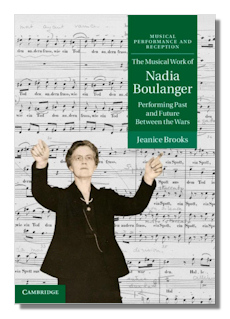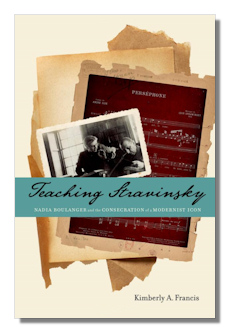
The Internet's Premier Classical Music Source
Related Links
-
Introduction
Acoustics
Ballet
Biographies
Chamber Music
Composers & Composition
Conducting
Criticism & Commentary
Discographies & CD Guides
Fiction
History
Humor
Illustrations & Photos
Instrumental
Lieder
Music Appreciation
Music Education
Music Industry
Music and the Mind
Opera
Orchestration
Reference Works
Scores
Thematic Indices
Theory & Analysis
Vocal Technique
Search Amazon
Recommended Links
Site News
 Book Review
Book Review
Nadia Boulanger Monographs

The Musical Work of Nadia Boulanger
Performing Past and Future Between the Wars
Jeanice Brooks
Cambridge University Press, 2013, xvi, 289 pages
(Musical Performance and Reception)
ISBN-10: 1107009146
ISBN-13: 978-1107009141


Teaching Stravinsky
Nadia Boulanger and the Consecration of a Modern Icon
Kimberly A. Francis
Oxford University Press, 2015, xxiii, 266 pages
ISBN-10: 0199373698
ISBN-13: 978-0199373697 (hardback, alk. paper)
These two recent scholarly monographs have a few things in common: they each are focused strictly on certain aspects of Boulanger's career. They each include some biographical treatment of Boulanger, but within circumscribed limits. Both take a feminist tack, especially Francis. These authors cite one another. They each include extensive footnotes, with the French original of letters and other material appearing in translation in the text. And they both add to the understanding of this immensely talented and influential twentieth-century musician, through their use of source material only recently available, which confirms, for instance, how much Nadia loved, in tern, her early mentor Raoul Pugno, and then Stravinsky. But neither author says much about the many successful American students of this great teacher, little more than does the disappointing biography by Léonie Rosestiel. Granted that is not their aim, but I keep hoping. Harold Shapero, for example, who also knew and revered Stravinsky, and who studied with Boulanger at Longy following his graduation from Harvard and winning the Prix de Rome, identified Boulanger as the most influential of all his distinguished teachers. He dedicated his Serenade for String Orchestra to her.
Brooks begins with Boulanger's early career and shows how Boulanger's reputation and influence grew out of the French upper-class Salon tradition in which important people regularly found the Boulangers "at home." Francis speaks – more often than she might – of Boulanger's "cultural capital," a term she takes from the sociologist Bourdieu, and which would appear to be the equivalent of the ability to influence.
Brooks traces Boulanger's conducting career, in Europe and America, with strong stress on her programming practice As with many in the twentieth century, she loved very old music, as well as the new music represented especially by Stravinsky. She arranged concert programs combining Bach and Stravinsky; in one concert a Monteverdi Sonata and Mozart's Clarinet Concerto followed by Psaume by Igor Markevich (one of her many students, later a famous conductor) and concluding with a Bach cantata. Boulanger scorned straight chronological programs. She wanted to show how old and new works, heard together, often have similarities of harmony or other musical characteristics in common. She also wanted individual works to stand out in a program to emphasize their uniqueness. In the case of the Fauré Requiem, notably, she insisted that it be placed last on a program. She was known to cancel involvements in which her wishes about program arrangement did not prevail.
One of Brooks most interesting chapters deals with a strong analogy involving collections of visual artworks. The Frick Gallery in New York and the Isabel Stuart Gardner Museum in Boston, she notes, were the result of the tastes of particular wealthy collectors and contain great works selected by those individuals. I happen to know that Gardner was insistent that the particular arrangement and juxtaposition of individual works remain thus in perpetuity. Brooks notes that a Vermeer and a Rembrandt were placed so that one could see them both from the same vantage. (She does not add that precisely these were among the works stolen in an unsolved heist a number of years ago; I can only infer that the mastermind of the theft had tastes similar to Gardner's.)
Francis wants to demonstrate the importance of Nadia Boulanger through an account of how she worked closely with Stravinsky starting in 1929 when she accepted Stravinsky's pianist son Soulima as her "pupil," a word Boulanger constantly used despite how far advanced the hundreds of her students typically were when they came to her. Francis relates how Boulanger worked closely with Stravinsky on some of his scores, editing them particularly with respect to clarifying performance indications, and correcting them for publication. Stravinsky respected her judgment and expertise, starting with the piano/vocal score of Symphonie de psaumes and as late as the preparation of the French version of The Rake's Progress. She "workshopped" Perséphone. The index to Francis' book lists no fewer than forty-six works by Stravinsky with which Boulanger had something to do. Nadia also worked assiduously to obtain concerts for Stravinsky, notably during her early visits of America. She had a lot to do with obtaining for Stravinsky the commission for the Dumbarton Oaks Concerto and she was given the right to conduct its premiere.
Among the surprises in Teaching Stravinsky – and I am not going to spoil them all – are some recently established facts or strong suspicions about the parentage of both Nadia and Lili Boulanger, and reports that instead of being a Russian princess, as she claimed, her mother Raissa was actually a Polish Jew. Francis speculates that if that were to have been uncovered by the Nazis Nadia would have been in grave danger after the German occupation of Paris; hence Nadia's urgency in getting to America by way of Lisbon in 1941. This clearly has biographical significance for Nadia.
I can recommend both these volumes to those interested in the career of one of the great musicians of the last century.
Copyright © 2015, R. James Tobin



















